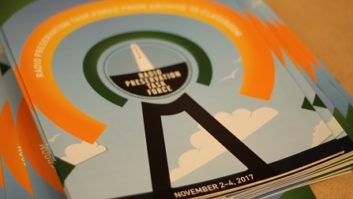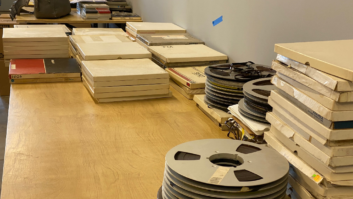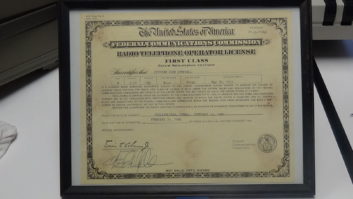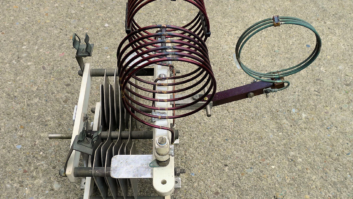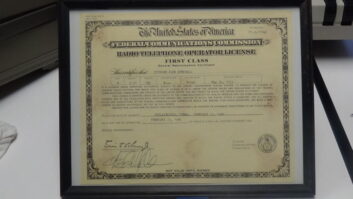The author is senior director, WGBH Media Library and Archives, and project director for the American Archive of Public Broadcasting.
Many public radio stations in the United States had similar beginnings; this article gives a brief history of WGBH radio and information about the American Archive of Public Broadcasting.
FROM THE EDITOR
Here is one in a series of guest commentaries in association with the Radio Preservation Task Force. In November the task force will hold its second conference on Capitol Hill with participants from the public, private and educational sectors. They will focus on strategies for preservation and classroom implementation of historic federal, noncommercial and local radio recordings.
— Paul McLane
WGBH is a leading public radio and TV station based in Boston. It traces its beginnings to the 1830s, when John Lowell Jr. bequeathed money to begin the Lowell Institute. Its mission was to fund free public lectures to help educate the citizens of the city.
During the mid-20th century, with the development of broadcast technology, and thus potential broader reach for the lectures, the Lowell Institute decided to broadcast the lectures via radio. Early broadcasts were on commercial radio stations, borrowing time when it was available. The Lowell Institute Cooperative Broadcasting Council (LICBC) grew tired of begging air time on commercial stations and never being able to develop a real schedule. In the late 1940s, the FCC began to issue more licenses to non-profit stations with the intent to increase the broadcast of educational programming; the LICBC took advantage of the opportunity to acquire a license.
WGBH(FM) went on the air in 1951 and WGBH(TV) followed in 1955. The call letters were based on the location of the transmitter on Great Blue Hill just outside Boston. The station’s mission was to further the goals of the LICBC by broadcasting programming such as lectures and concerts, to educate and inspire the citizenry of Boston. The LICBC formed a consortium from the leading educational and cultural institutions in the city to oversee the station. To this day presidents of four of these institutions remain on the station board of trustees.

Karen Cariani
RECORDING HISTORY
Originally, many non-commercial stations were on university campuses. WGBH originally was housed on the campus of MIT at 84 Massachusetts Ave. in Cambridge. Its first broadcast was a concert of the Boston Symphony. Early productions were local news and often reports of national events targeted for local audiences. The audience was limited to the geographic circle the transmitter could reach. The station soon created new programming for children, like “Children’s Circle” in 1952, and arts and culture programs like “The Creative Mind,” which interviewed artists such as Agnes de Mille, who discussed choreography in 1958.
In 1961 there was a fire at the MIT studios. Much of the archive of early programs was destroyed. But the community came together to keep WGBH on the air. Radio was back on the air within 24 hours; getting the TV broadcast back on the air took a little more time.
At the new studios, WGBH continued to broadcast lectures and the symphony but also began to cover national events for local audiences. A loose network of stations formed called the Educational Radio Network, sharing reporting and programming to cover national events more effectively and economically.
In 1963, eight years before National Public Radio hit the airwaves, WGBH and this small network of radio stations teamed up to broadcast full, uninterrupted coverage of the March on Washington for Jobs and Freedom. As the march unfolded, quarter-inch tape rolled in Boston, recording speeches by Martin Luther King Jr. and John Lewis of the Student Non-Violent Coordinating Committee; music by Mahalia Jackson and a very young Bob Dylan and Joan Baez; an interview with Marlon Brando and much more — 15 hours altogether. These tapes, now in the WGBH Media Library and Archives and available online at Open Vault, are the only complete audio coverage of the broadcast in existence.
Only ERN and CBS television offered complete live coverage of the March. Mainstream America had never heard Martin Luther King Jr. or other civil rights leaders deliver their full argument for their cause. The Educational Radio Network offered a chance for people across the country to monitor the events and absorb the message of civil rights.
FUNDING CHALLENGES
WGBH continued to produce programs like “Reading Aloud” for children, but in the 1980s radio had less funding than TV. With the new PBS network, and satellite delivery, TV had broader reach. Major series like “Nova,” “Frontline” and “Masterpiece Theatre” were grabbing attention and funding. Funding for radio was limited and the station put most of its efforts to broaden the TV reach with new productions.
Radio was, however, ahead of the game digitally with online streaming, taking advantage of the internet, podcasts and possible international collaborative broadcasts. It was much easier to stream and distribute via radio/audio than TV; rights are less complicated, file sizes are smaller and the technology is less complex.
At WGBH, radio has gotten a major boost with the resurgence of news programming. Not only does it broadcast the national feed from NPR but it also creates and airs local programs for the Boston audience. The programs continued to inform, entertain and educate, and are now once again getting more resources.
WGBH, like so many local public stations, began with a mission to educate the public, and it wasn’t the only one to keep an archive. Similar types of programs exist at stations across the country. In order to help preserve this great heritage, WGBH and the Library of Congress were awarded the stewardship of the American Archive of Public Broadcasting in 2013.
AAPB
The American Archive of Public Broadcasting is a collection of radio and TV materials created by or for public TV and radio in the US dating back to the 1950s. The goal is to preserve for historical purposes and for access by the public, the significant historical content created by public media, and to coordinate a national effort to save at-risk public media before its content is lost to posterity.
About half of the 40,000 hours in the initial digital collection are radio archives. The collection is being ingested into the Library of Congress preservation system for long-term preservation. Initial launch of the website (http://americanarchive.org) in February 2015 gave the public access to 2.5 million inventory records. All the media is accessible on location at WGBH and the Library of Congress and now about 20,000 items are available through the On-Line Reading Room to the general public in the United States.
The collection represents more than 100 stations across the country, and mostly locally produced content. Examples of highlighted local content can be found in the curated exhibits (http://americanarchive.org/exhibits). Some minimal cataloguing to allow easier access by grouping programs into topics has been accomplished, but there is much still to do to improve access.
Today WGBH still records lectures to share with the broader public. Those programs are now part of the AAPB for a future audience. Radio continues to broadcast the rich cultural history of America. The American Archive collection creates an opportunity to discover radio history and local community history across the country over the last 60 years.





